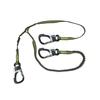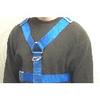For such a potentially dangerous sport, sailors are notoriously lax at obeying safety requirements - and ignoring Murphy's Law, which clearly states that you'll be knocked overboard when you least suspect it, on a beautiful, calm day, right after you say that you 'wouldn't be caught dead wearing a harness on a day like today'.
The fact of the matter is that it may only take a single scary incident to change your mind about hearing a harness while boating, but generally speaking, the best set of rules we've seen on the subject is that you should clip in when any of the following conditions are true:
- You are singlehanding the boat
- Are on a night passage
- Have water temps below 15° C (60° F)
- Have air temps below 10° C (50° F)
- Have reduced visibility of any sort (rain, fog, etc)
- Are boating with inexperienced crew that most likely could not perform a MOB rescue
- Waves are more than 2 ft in height and/or you probably couldn't easily swim to shore if you needed to
Ideally, everyone on board the vessel should be well trained to deal with Man Overboard situations. However, in reality, when was the last time you or your crew trained for one? Perhaps more importantly, was it practiced in rough seas and poor visibility - the type of situation in which such a situation is most likely to occur? Probably not!
Therefore, perhaps the key is stay on the boat in the first place!
Let's split this "staying out of the water" category into the three main pieces of equipment:
 HARNESS
HARNESS
There really is no reason to not wear a harness, but if anything it might be due to a lack of comfort. In reality, a harness can be quite comfy, so try a few on at the shop to find your favourite. Honestly, put the price tag aside for a moment; if it's comfortable, you'll wear it. For this reason, we generally recommend PFD/Harness combinations (these are in our PFD/Lifejackets category) so with one piece of equipment, you've got all your bases covered.
I have worn my harness under my lifejacket (traditional, non-inflatable) which lacks the comfort provided by combination PFD/Harnesses. Tolerable, but for boaters who need every incentive to wear a harness, consider a combination.
TETHER
Tethers are usually 6 feet long. This is not particularily helpful for anyone under 6 feet in height, which is most of us. Consider a tether with integrated bungee to keep it from being tripped on. Perhaps better, consider carrying 2 tethers; one full-length, and a second half-length (3 ft), or best, a Y-shaped tether with three hooks - this will provide a variety of options, and allow you to hook onto 2 places at once if necessary (especially when crossing the boat or going around obstacles).
 Do not use a tether made of round rope. You'll step on it and lose your footing. Webbing/Strap is best, and its breaking strength should be rated in the thousands (not hundreds) of pounds.
Do not use a tether made of round rope. You'll step on it and lose your footing. Webbing/Strap is best, and its breaking strength should be rated in the thousands (not hundreds) of pounds.
Tether hooks should be locking. Regular snaps are not sufficient; be sure that the snap cannot open with direct pressure - it should only open when pressed from two directions, or require a fair amount of hand strength to do so. Some people request hooks with a quick release, in case you need to escape while the tether is under pressure. We do not recommend or discourage a quick release function - but there is very little evidence that it is actually necessary. We can picture that in an MOB situation, you might accidentally release yourself while thrashing about (once again, Murphy's Law). In the situation of the boat rolling over, it might be a good idea to unhook - but then again, perhaps not. The boat will come back upright, and if it is slow to do so, you might have an opportunity to unclip before running out of air.
In any case, you should practice clipping and unclipping - at rest and while the tether is under pressure - over and over again until you can do it automatically and in a fraction of a second. Carry a rigging knife if you think you might need to cut yourself from the tether.
JACKLINES
Jacklines run from as far back towards the stern up to a bow cleat. Generally you should have jacklines on each side of the boat, but some smaller, narrow boats easily accomodate a single jackline up the centreline. Inside or outside the shrouds is your choice, but an advantage of being inside is that you won't have to squeeze between the shrouds and lifelines. Another advantage is that if you are swept overboard while forward of the shrouds, you won't be dragged all the way to the stern. However, if the stern is the easiest place to get back onboard, then you may choose otherwise! Every boat will accomodate lines differently.
 Jacklines should not be made of rope due to the tripping hazard; they should be made of very, very strong webbing with a breaking strength of 5000 lbs or more. Remember, any pressure will be sideways on the jackline, so the pressure is much higher than would be experienced if simply pulled end-to-end, which is why they need to be so strong. We have a calculator on our Cordage & Rope page if you would like to calculate the theoretical loads exerted sideways on jacklines.
Jacklines should not be made of rope due to the tripping hazard; they should be made of very, very strong webbing with a breaking strength of 5000 lbs or more. Remember, any pressure will be sideways on the jackline, so the pressure is much higher than would be experienced if simply pulled end-to-end, which is why they need to be so strong. We have a calculator on our Cordage & Rope page if you would like to calculate the theoretical loads exerted sideways on jacklines.
There is only one situation when rope is sufficient - while crewing at sea on a transit, we were skeptical about the jacklines we were provided with, so we tested them. On the second tug (by hand), the thin webbing snapped! There is no way it would have withstood the pressure of a crew member being thrown overboard. We quickly replaced them with a rope substitute! UV exposure played a role as well, so consider removing your jacklines while in harbour for long periods (just remember to reinstall them!)
Jacklines should be attached to the strongest cleats you have on board. While in the cockpit, use your 6 foot tether, hooked into strong padeyes. A cockpit jackline will just get confusing and tripped on.
IMPORTANT WARNINGS!
- Do not hook into stanchions, lifelines, or your steering pedestal. This hardware is not nearly strong enough.
- Stay hooked in while in the cockpit at night, particularily if you are urinating off the stern!
- Carry your other safety gear in your suit whether or not you are wearing a harness; strobe light, flare, water dye, whistle, knife, etc.
- Always be prepared for the worst case scenario!



































